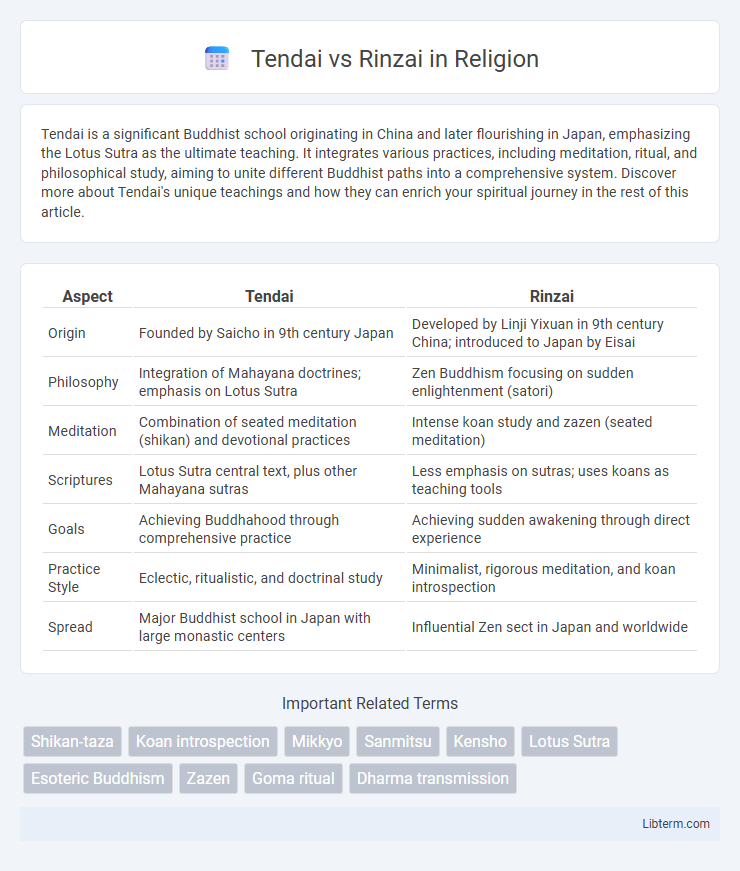Tendai is a significant Buddhist school originating in China and later flourishing in Japan, emphasizing the Lotus Sutra as the ultimate teaching. It integrates various practices, including meditation, ritual, and philosophical study, aiming to unite different Buddhist paths into a comprehensive system. Discover more about Tendai's unique teachings and how they can enrich your spiritual journey in the rest of this article.
Table of Comparison
| Aspect | Tendai | Rinzai |
|---|---|---|
| Origin | Founded by Saicho in 9th century Japan | Developed by Linji Yixuan in 9th century China; introduced to Japan by Eisai |
| Philosophy | Integration of Mahayana doctrines; emphasis on Lotus Sutra | Zen Buddhism focusing on sudden enlightenment (satori) |
| Meditation | Combination of seated meditation (shikan) and devotional practices | Intense koan study and zazen (seated meditation) |
| Scriptures | Lotus Sutra central text, plus other Mahayana sutras | Less emphasis on sutras; uses koans as teaching tools |
| Goals | Achieving Buddhahood through comprehensive practice | Achieving sudden awakening through direct experience |
| Practice Style | Eclectic, ritualistic, and doctrinal study | Minimalist, rigorous meditation, and koan introspection |
| Spread | Major Buddhist school in Japan with large monastic centers | Influential Zen sect in Japan and worldwide |
Introduction to Tendai and Rinzai
Tendai and Rinzai are two prominent schools of Japanese Buddhism with distinct philosophical approaches and meditation practices. Tendai emphasizes the Lotus Sutra's teachings and integrates a holistic approach to enlightenment, blending doctrinal study with diverse meditative techniques. Rinzai centers on Zen meditation (zazen) and koan practice, aiming for sudden awakening through direct insight and disciplined training.
Historical Origins of Tendai and Rinzai
Tendai Buddhism traces its origins to the Chinese Tiantai school founded by Zhiyi during the Sui dynasty, introduced to Japan by Saicho in the early 9th century, establishing a comprehensive doctrinal system centered on the Lotus Sutra. Rinzai Zen, derived from the Linji school founded by the Chinese monk Linji Yixuan during the Tang dynasty, was brought to Japan by Eisai in the late 12th century, emphasizing sudden enlightenment through koan practice. These historical developments reflect Tendai's scholastic and inclusive approach versus Rinzai's focus on direct meditative experience and rigorous discipline.
Core Philosophical Differences
Tendai Buddhism emphasizes the Lotus Sutra's universal salvation and integrates meditation with doctrinal study, promoting a harmonious balance between insight and ritual practice. Rinzai Zen centers on sudden enlightenment through koan practice and direct experiential realization, prioritizing disciplined meditation over textual study. The core philosophical difference lies in Tendai's doctrinal inclusiveness and gradual path versus Rinzai's emphasis on abrupt awakening and direct mind-to-mind transmission.
Key Practices in Tendai Buddhism
Tendai Buddhism emphasizes the practice of the Lotus Sutra through extensive meditation, chanting (especially the Odaimoku), and esoteric rituals derived from Vajrayana traditions. Key practices include shikan meditation (calm abiding with insight) and the integration of teachings from both the Mahayana and Vajrayana paths, aiming for a comprehensive approach to enlightenment. The Tendai tradition also stresses the concept of "original enlightenment" (hongaku), encouraging practitioners to realize their innate Buddha nature in daily life.
Essential Methods in Rinzai Zen
Rinzai Zen emphasizes the use of koan practice as an essential method to achieve sudden enlightenment by challenging the practitioner's logical thinking and encouraging direct insight into reality. This approach contrasts with Tendai Zen, which incorporates extensive study of sutras and a more gradual, comprehensive path toward enlightenment. Rinzai's rigorous meditation techniques and use of sharp, paradoxical questions help break conventional patterns of thought, fostering transformative, immediate awakening.
Approach to Meditation and Enlightenment
Tendai Buddhism emphasizes a comprehensive approach to meditation, integrating practices such as mantra chanting, visualization, and seated meditation (zazen) to cultivate enlightenment gradually through universal Buddha-nature. Rinzai Zen centers on rigorous, direct meditation using koan practice to provoke sudden insight (satori) and immediate realization of one's true nature. The Tendai tradition advocates for a systematic path combining doctrinal study and practice, while Rinzai prioritizes intense, experiential awakening through disciplined meditation techniques.
Major Texts and Teachings
Tendai Buddhism centers on the Lotus Sutra as its primary text, emphasizing the concept of Ekayana, or "One Vehicle," which teaches the universal potential for enlightenment among all beings. Rinzai Zen prioritizes direct experience through meditation (zazen) and koan practice, focusing on the teachings found in the recorded sayings of Linji Yixuan and classical Zen texts like the Mumonkan. Tendai integrates ritual, scholastic study, and esoteric practices, while Rinzai stresses sudden awakening and rigorous discipline within the Soto and Rinzai Zen traditions.
Influence on Japanese Culture
Tendai Buddhism, with its comprehensive doctrinal system and emphasis on the Lotus Sutra, profoundly shaped Japanese religious thought, art, and literature during the Heian period. Rinzai Zen, known for its rigorous meditation practices and koan study, heavily influenced samurai culture, tea ceremony, ink painting, and garden design from the Kamakura era onward. Both schools contributed unique philosophical perspectives, integrating spirituality with cultural expressions across Japan's historical development.
Notable Figures and Lineages
Notable figures in the Tendai school include Saicho, the founder who established the tradition on Mount Hiei, emphasizing the Lotus Sutra and integrating esoteric practices. The Rinzai school, founded by Eisai, is known for Linji Yixuan's influence, emphasizing koan practice and sudden enlightenment. Lineages in Tendai remain centralized under the headquarters at Enryaku-ji, while Rinzai is characterized by multiple independent lineages, such as the Myoshin-ji and Daitoku-ji branches, reflecting diverse interpretations within Zen.
Contemporary Relevance and Legacy
Tendai Buddhism emphasizes inclusive practice and doctrinal synthesis, maintaining significant influence in Japanese education and culture through institutions like Enryaku-ji Temple and Tendai-affiliated universities. Rinzai Zen's focus on koan meditation and sudden enlightenment has shaped modern mindfulness practices and Zen arts, impacting global spiritual communities and contemporary psychotherapy. Both traditions contribute to Japan's religious landscape by preserving ancient teachings while adapting to modern spiritual needs.
Tendai Infographic

 libterm.com
libterm.com